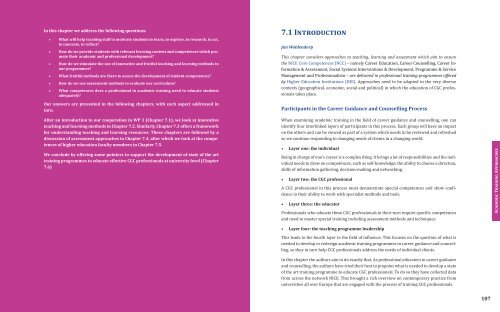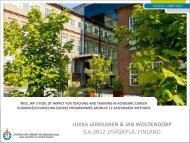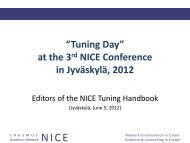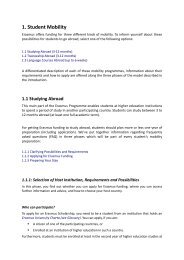NICE HANDBOOK â Academic training of Career ... - Nice-network.eu
NICE HANDBOOK â Academic training of Career ... - Nice-network.eu
NICE HANDBOOK â Academic training of Career ... - Nice-network.eu
You also want an ePaper? Increase the reach of your titles
YUMPU automatically turns print PDFs into web optimized ePapers that Google loves.
In this chapter we address the following questions:◆◆◆◆◆◆◆◆◆◆◆◆What will help teaching staff to motivate students to learn, to explore, to research, to act,to innovate, to reflect?How do we provide students with relevant learning content and competences which promotetheir academic and pr<strong>of</strong>essional development?How do we stimulate the use <strong>of</strong> innovative and fruitful teaching and learning methods inour programmes?What fruitful methods are there to assess the development <strong>of</strong> student competences?How do we use assessment methods to evaluate our curriculum?What competences does a pr<strong>of</strong>essional in academic <strong>training</strong> need to educate studentsadequately?Our answers are presented in the following chapters, with each aspect addressed inturn.After an introduction to our cooperation in WP 3 (Chapter 7.1), we look at innovativeteaching and learning methods in Chapter 7.2. Similarly, Chapter 7.3 <strong>of</strong>fers a frameworkfor understanding teaching and learning resources. These chapters are followed by adiscussion <strong>of</strong> assessment approaches in Chapter 7.4, after which we look at the competences<strong>of</strong> higher education faculty members in Chapter 7.5.We conclude by <strong>of</strong>fering some pointers to support the development <strong>of</strong> state <strong>of</strong> the art<strong>training</strong> programmes to educate effective CGC pr<strong>of</strong>essionals at university level (Chapter7.6)7.1 IntroductionJan WoldendorpThis chapter considers approaches to teaching, learning and assessment which aim to ensurethe <strong>NICE</strong> Core Competences (NCC) – namely <strong>Career</strong> Education, <strong>Career</strong> Counselling, <strong>Career</strong> Information& Assessment, Social Systems Interventions & Development, Programme & ServiceManagement and Pr<strong>of</strong>essionalism – are delivered in pr<strong>of</strong>essional <strong>training</strong> programmes <strong>of</strong>feredby Higher Education Institutions (HEI). Approaches need to be adapted to the very diversecontexts (geographical, economic, social and political) in which the education <strong>of</strong> CGC pr<strong>of</strong>essionalstakes place.Participants in the <strong>Career</strong> Guidance and Counselling ProcessWhen examining academic <strong>training</strong> in the field <strong>of</strong> career guidance and counselling, one canidentify four interlinked layers <strong>of</strong> participants in this process. Each group will have an impacton the others and can be viewed as part <strong>of</strong> a system which needs to be reviewed and refreshedso we continue responding to changing needs <strong>of</strong> clients in a changing world.◆◆Layer one: the individualBeing in charge <strong>of</strong> one’s career is a complex thing. It brings a lot <strong>of</strong> responsibilities and the individualneeds to draw on competences, such as self-knowledge, the ability to choose a direction,skills <strong>of</strong> information gathering, decision-making and <strong>network</strong>ing.◆◆Layer two: the CGC pr<strong>of</strong>essionalA CGC pr<strong>of</strong>essional in this process must demonstrate special competences and show confidencein their ability to work with specialist methods and tools.◆◆Layer three: the educatorPr<strong>of</strong>essionals who educate these CGC pr<strong>of</strong>essionals in their turn require specific competencesand need to master special <strong>training</strong> including assessment methods and techniques.<strong>Academic</strong> Training Approaches◆◆Layer four: the teaching programme leadershipThis leads to the fourth layer in the field <strong>of</strong> influence. This focuses on the question <strong>of</strong> what isneeded to develop or redesign academic <strong>training</strong> programmes in career guidance and counselling,so they in turn help CGC pr<strong>of</strong>essionals address the needs <strong>of</strong> individual clients.In this chapter the authors aim to do exactly that. As pr<strong>of</strong>essional educators in career guidanceand counselling, the authors have tried their best to pinpoint what is needed to develop a state<strong>of</strong> the art <strong>training</strong> programme to educate CGC pr<strong>of</strong>essionals. To do so they have collected datafrom across the <strong>network</strong> <strong>NICE</strong>. This brought a rich overview on contemporary practice fromuniversities all over Europe that are engaged with the process <strong>of</strong> <strong>training</strong> CGC pr<strong>of</strong>essionals.107






